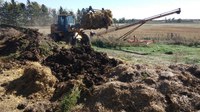Producers Need Disposal Plan for Dead Livestock
(Click the image below to view a high-resolution image that can be downloaded)
The death of animals is part of any livestock operation.
“With lambing underway and calving just around the corner, now is the time for producers to have a plan for disposing of the mortalities quickly,” says Mary Keena, North Dakota State University Extension livestock environmental management specialist at the Carrington Research Extension Center. “Timely disposal of these mortalities is critical to preventing the spread of disease, as well as protecting water quality.”
Rendering, incineration, burial and composting are approved methods of carcass disposal in North Dakota.
“Carcass abandonment is not considered an acceptable disposal practice,” Keena stresses.
Rendering is the process of converting animal carcasses into pathogen-free, useful byproducts such a feed protein. The process involves using high-temperature, pressurized steam. However, rending no longer is a common disposal method in North Dakota because of the lack of facilities and the cost.
Incineration is the thermal destruction of carcasses using fuel such as propane, diesel or natural gas. It requires considerable energy. The cost of incineration may be a limiting factor for some producers. Also, large carcasses often exceed the incinerator’s capacity. Open-pit burning of carcasses is an acceptable last-resort disposal option.
Burial is a common method of carcass disposal, but selecting the proper burial site and maintaining it are important. Areas with sandy or gravelly soil and a shallow groundwater table must not be used a burial site.
Also, burial is difficult during the winter and isn’t an option during flooding or in areas prone to flooding. The disposal site should be away from residences, drinking water wells or shallow aquifers.
Keena says the best option might be composting, which is a naturally occurring process that breaks the carcass into basic elements via microorganisms and heat generated during composting. Composting is a simple process that requires few materials and minimal maintenance.
Here are Keena’s tips for composting:
- Build a pile if composting one animal.
- Build a windrow if composting several animals.
- Use material such as straw or old hay for the base, manure or spoiled silage for the bulking material, and straw, old hay or sawdust as cover material.
This is the process for composting:
- Start with 2 feet of base material in a windrow or pile, depending on how many carcasses will be composted.
- Lay the carcass on top of the base. Have at least 1 foot of base material between the perimeter of the carcass and the edge of the base.
- Cover the carcass with 8 to 10 inches of bulking material.
- Cover the entire pile or windrow with 2 feet of cover material. The cover material should be placed on the top and sides, with no part of the carcass showing. The pile needs a good cap to keep predators out and seal in heat.
To maintain the compost site:
- Leave the pile or windrow undisturbed to keep heat sealed in during the very cold winter months.
- Aerate the pile every two months using a loader from early spring until late fall.
- Make sure the pile or windrow always has sufficient cover material.
For more information:
- Contact Keena at 701-652-2951 or mary.keena@ndsu.edu
- Visit NDSU’s livestock environmental management website at https://www.ag.ndsu.edu/lem/resources
- See NDSU’s “Animal Carcass Disposal Options” publication at https://tinyurl.com/CarcassDisposal or “5 Easy Steps for Composting Dead Livestock” at https://tinyurl.com/StepstoCompostDeadLivestock
NDSU Agriculture Communication - Jan. 9. 2019
| Source: | Mary Keena, 701-652-2951, mary.keena@ndsu.edu |
|---|---|
| Editor: | Ellen Crawford, 701-231-5391, ellen.crawford@ndsu.edu |


